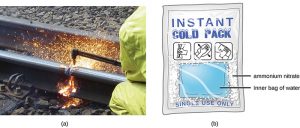Exothermic and Endothermic
Matter undergoing chemical reactions and physical changes can release or absorb heat. A change that releases heat is called an exothermic process. For example, the combustion reaction that occurs when using an oxyacetylene torch is an exothermic process—this process also releases energy in the form of light as evidenced by the torch’s flame (see figure below). A reaction or change that absorbs heat is an endothermic process. A cold pack used to treat muscle strains provides an example of an endothermic process. When the substances in the cold pack (water and a salt like ammonium nitrate) are brought together, the resulting process absorbs heat, leading to the sensation of cold.

Another example of an exothermic reaction can be observed (or felt) in hand warmers. When working or playing outdoors on a cold day, you might use a hand warmer to warm your hands. A common reusable hand warmer contains a mixture of sodium acetate and water, along with a metal disc. Bending the disk initiates crystallization of the sodium acetate. The process of crystallization is similar to the formation of crystal rock candy discussed in an earlier chapter, although the formation of rock candy does not release as much heat. The crystallization of sodium acetate is exothermic, and the heat produced by this process is released into your hands, thereby warming them (at least for a while). This is an example of a physical process that is exothermic, since crystallization is a physical change (no chemical reaction occurs). If the hand warmer is reheated, the sodium acetate redissolves and can be reused.

Another common hand warmer produces heat when it is ripped open, exposing iron and water in the hand warmer to oxygen in the air. This is an example of an exothermic chemical reaction, since the iron, water, and oxygen react with each other in a chemical change.
Example: Identifying Exothermic or Endothermic Processes
- The average body temperature of a person is 37°C, while the average surrounding temperature is 22°C. Is overall human metabolism exothermic or endothermic?
- Cold-blooded animals absorb heat from the environment for part of the energy they need to survive. Is this an exothermic or an endothermic process?
Solution
- Since a person’s body is at a higher temperature than the surrounding environment, the person’s body will release heat to the surroundings. From this observation of temperature, we can determine that overall human metabolism is exothermic.
- Since cold-blooded animals absorb heat from the environment, we have evidence that this is an endothermic process.
Attributions
This page is based on “Chemistry 2e” by Paul Flowers, Klaus Theopold, Richard Langley, William R. Robinson, PhD, Openstax which is licensed under CC BY 4.0. Access for free at https://openstax.org/books/chemistry-2e/pages/1-introduction
This page is based on “The Basics of General, Organic, and Biological Chemistry” by David W Ball, John W Hill, Rhonda J Scott, Saylor which is licensed under CC BY-NC-SA 4.0. Access for free at http://saylordotorg.github.io/text_the-basics-of-general-organic-and-biological-chemistry/index.html

